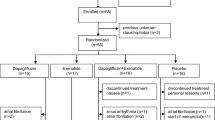Abstract
Objective: Pharmacokinetics, pharmacodynamic effects and tolerability of 200 mg valsartan, once-daily for 8 days, were investigated in 16 healthy, normotensive volunteers on a normal sodium diet.
Methods: This was a double-blind, placebo-controlled, randomized crossover study. Drug concentrations in plasma and urine, angiotensin II (Ang II) concentrations in plasma, systolic (SBP) and diastolic (DBP) blood pressure, heart rate (HR) in the supine position and 3 min after passive head-up tilting, as well as safety parameters (ECG, clinical chemistry and hematology, renal water and electrolyte excretion) were measured over 24 h after the first dose (day 1) and at steady state on day 8.
Results: Absorption and distribution of valsartan were rapid (Cmax, 2 h; t½λ1 < 1 h), followed by a slower terminal elimination phase (t½λ2, 6 h) on days 1 and 8, with little accumulation in plasma (increase of 20% on day 8). Less than 10% of the dose was excreted unchanged in urine. The increase in plasma Ang II (Cmax, 6 h) was significantly enhanced at steady state. Supine SBP and DBP significantly decreased on day 8 only, by an average of −3.6 and −2.4 mmHg, respectively, versus placebo, without a concomitant increase in HR. Upon passive tilting, the increase in DBP, normally reinforced by sympathetic renin release, was slightly but significantly blunted on day 1 (−2.0 mmHg) and day 8 (−4.0 mmHg) of treatment with valsartan versus placebo. The orthostatic reflex increase in HR was slightly enhanced compared with placebo by an average of 2.8 beats · min−1 on day 1 and by 2.9 beats · min−1 on day 8. Valsartan was well tolerated and had no influence on ECG, clinical laboratory parameters, and water, electrolyte and uric acid excretion.
Conclusions: Pharmacokinetics of valsartan are unchanged after multiple once-daily dosing, with little (expected) accumulation in plasma. Effects of 200 mg valsartan on blood pressure in healthy subjects on a normal sodium intake are small and become more prominent after repeated dosing. Indirect evidence of AT1 blockade by valsartan is demonstrated by an increase of plasma Ang II and by a blunted DBP response to passive tilting. The decrease in blood pressure at steady state enhances the increase in plasma Ang II. Valsartan is well tolerated and is devoid of effects on water, electrolyte and uric acid excretion at 200 mg per day in healthy normotensive volunteers.
Similar content being viewed by others
Author information
Authors and Affiliations
Additional information
Received: 5 December 1996 / Accepted in revised form: 28 February 1997
Rights and permissions
About this article
Cite this article
Müller, P., Flesch, G., de Gasparo, M. et al. Pharmacokinetics and pharmacodynamic effects of the angiotensin II antagonist valsartan at steady state in healthy, normotensive subjects. E J Clin Pharmacol 52, 441–449 (1997). https://doi.org/10.1007/s002280050317
Issue Date:
DOI: https://doi.org/10.1007/s002280050317




